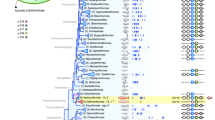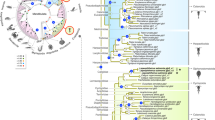Abstract
P2X receptors are membrane ion channels gated by extracellular ATP1,2 that are found widely in vertebrates, but not previously in microbes. Here we identify a weakly related gene in the genome of the social amoeba Dictyostelium discoideum, and show, with the use of heterologous expression in human embryonic kidney cells, that it encodes a membrane ion channel activated by ATP (30–100 μM). Site-directed mutagenesis revealed essential conservation of structure–function relations with P2X receptors of higher organisms. The receptor was insensitive to the usual P2X antagonists3 but was blocked by nanomolar concentrations of Cu2+ ions. In D. discoideum, the receptor was found on intracellular membranes, with prominent localization to an osmoregulatory organelle, the contractile vacuole. Targeted disruption of the gene in D. discoideum resulted in cells that were unable to regulate cell volume in hypotonic conditions. Cell swelling in these mutant cells was accompanied by a marked inhibition of contractile vacuole emptying. These findings demonstrate a new functional role for P2X receptors on intracellular organelles, in this case in osmoregulation.
This is a preview of subscription content, access via your institution
Access options
Subscribe to this journal
Receive 51 print issues and online access
$199.00 per year
only $3.90 per issue
Buy this article
- Purchase on Springer Link
- Instant access to full article PDF
Prices may be subject to local taxes which are calculated during checkout



Similar content being viewed by others
References
North, R. A. Molecular physiology of P2X receptors. Physiol. Rev. 82, 1013–1067 (2002)
Khakh, B. S. & North, R. A. P2X receptors as cell-surface ATP sensors in health and disease. Nature 442, 527–532 (2006)
Gever, J. R., Cockayne, D. A., Dillon, M. P., Burnstock, G. & Ford, A. P. Pharmacology of P2X channels. Pflügers Arch. 452, 513–537 (2006)
Nicke, A. et al. P2X1 and P2X3 receptors form stable trimers: a novel structural motif of ligand-gated ion channels. EMBO J. 17, 3016–3028 (1998)
Barrera, N. P., Ormond, S. J., Henderson, R. M., Murrell-Lagnado, R. D. & Edwardson, J. M. Atomic force microscopy imaging demonstrates that P2X2 receptors are trimers but that P2X6 receptor subunits do not oligomerize. J. Biol. Chem. 280, 10759–10765 (2005)
Coddou, C. et al. Histidine 140 plays a key role in the inhibitory modulation of the P2X4 nucleotide receptor by copper but not zinc. J. Biol. Chem. 278, 36777–36785 (2003)
Virginio, C., Church, D., North, R. A. & Surprenant, A. Effects of divalent cations, protons and calmidazolium at the rat P2X7 receptor. Neuropharmacology 36, 1285–1294 (1997)
Roberts, J. A. et al. Molecular properties of P2X receptors. Pflügers Arch. 452, 486–500 (2006)
Vial, C., Roberts, J. A. & Evans, R. J. Molecular properties of ATP-gated P2X receptor ion channels. Trends Pharmacol. Sci. 25, 487–493 (2004)
Chaumont, S., Jiang, L. H., Penna, A., North, R. A. & Rassendren, F. Identification of a trafficking motif involved in the stabilization and polarization of P2X receptors. J. Biol. Chem. 279, 29628–29638 (2004)
Allen, R. D. The contractile vacuole and its membrane dynamics. BioEssays 22, 1035–1042 (2000)
Zhu, Q. & Clarke, M. Association of calmodulin and an unconventional myosin with the contractile vacuole complex of Dictyostelium discoideum. J. Cell Biol. 118, 347–358 (1992)
Heuser, J. Evidence for recycling of contractile vacuole membrane during osmoregulation in Dictyostelium amoebae. Eur. J. Cell Biol. 85, 859–871 (2006)
Allen, R. D. & Naitoh, Y. Osmoregulation and contractile vacuoles of protozoa. Int. Rev. Cytol. 215, 351–394 (2002)
Gerald, N. J., Sianom, M. & De Lozanne, A. The Dictyostelium LvsA protein is localized on the contractile vacuole and is required for osmoregulation. Traffic 3, 50–60 (2002)
Wu, W. I., Yajnik, J., Siano, M. & De Lozanne, A. Structure–function analysis of the BEACH protein LvsA. Traffic 5, 346–355 (2004)
Jentsch, T. J., Hubner, C. A. & Fuhrmann, J. C. Ion channels: function unravelled by dysfunction. Nature Cell Biol. 6, 1039–1047 (2004)
Masse, K., Eason, R., Bhamra, S., Dale, N. & Jones, E. A. Comparative genomic and expression analysis of the conserved NTPDase gene family in Xenopus. Genomics 87, 366–381 (2006)
Ramjeesingh, M., Huan, L. J., Garami, E. & Bear, C. E. Novel method for evaluation of the oligomeric structure of membrane proteins. Biochem. J. 342, 119–123 (1999)
Acknowledgements
We thank H. Broomhead, L. Almond, K. Dossi and N. Aldren for their technical expertise during this study, and A. Mueller-Taubenberger for the gift of the pDEX 27 GFP vector. This work was supported by the Wellcome Trust, the Medical Research Council and the Lister Institute of Preventive Medicine.
Author information
Authors and Affiliations
Corresponding authors
Ethics declarations
Competing interests
Reprints and permissions information is available at www.nature.com/reprints. The authors declare no competing financial interests.
Supplementary information
Supplementary Figure
This file contains Supplementary Figure 1 with Legend. (PDF 145 kb)
Rights and permissions
About this article
Cite this article
Fountain, S., Parkinson, K., Young, M. et al. An intracellular P2X receptor required for osmoregulation in Dictyostelium discoideum. Nature 448, 200–203 (2007). https://doi.org/10.1038/nature05926
Received:
Accepted:
Issue Date:
DOI: https://doi.org/10.1038/nature05926
This article is cited by
-
Epithelial wound healing in Clytia hemisphaerica provides insights into extracellular ATP signaling mechanisms and P2XR evolution
Scientific Reports (2023)
-
ATP signaling in the integrative neural center of Aplysia californica
Scientific Reports (2021)
-
A two-pore channel protein required for regulating mTORC1 activity on starvation
BMC Biology (2020)
-
Drosophila taste neurons as an agonist-screening platform for P2X receptors
Scientific Reports (2020)
-
Dictyostelium discoideum RabS and Rab2 colocalize with the Golgi and contractile vacuole system and regulate osmoregulation
Journal of Biosciences (2016)
Comments
By submitting a comment you agree to abide by our Terms and Community Guidelines. If you find something abusive or that does not comply with our terms or guidelines please flag it as inappropriate.



